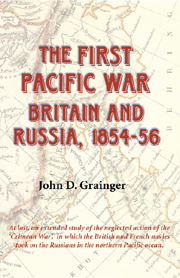Book contents
1 - The Royal Navy in the Pacific
Published online by Cambridge University Press: 12 September 2012
Summary
The only institution in the world in the middle of the nineteenth century which was present in all the oceans and close to all the continents and islands was the Royal Navy. Its presence in the Pacific had been gradually extending since the 1820s, approaching the ocean from several directions. The establishment of a British settlement colony, New South Wales, on the east coast of Australia in 1788 was one stage in the process. Along the coasts of southeast and east Asia the British presence was due to the trading activities of the East India Company, which had traded in Canton for well over a century. The Company's ships were armed, but its officers avoided trouble if possible. Trading posts under British control, either the Company's or otherwise, had extended eastwards: Penang in Malaya in 1786, Singapore in 1819, just as the Company's control of India extended inland at the same time. By acquiring control of Cape Town in 1806, and western Australia in 1839, the British effectively made the Indian Ocean a British lake. However, when the Company lost its monopoly of (British) trade with China and the East in 1833, by a revision of its charter by Parliament, at once things began to change. The opening of the trade brought many more British ships to Chinese waters.
The third approach to the Pacific was by way of the South Atlantic Ocean and round Cape Horn. Here it was the collapse of the monolithic Spanish empire in South America between 1810 and 1825 which enticed the Royal Navy into the Pacific.
- Type
- Chapter
- Information
- The First Pacific WarBritain and Russia, 1854–56, pp. 1 - 26Publisher: Boydell & BrewerPrint publication year: 2008



